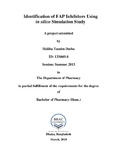Identification of FAP inhibitors using in silico simulation study

View/Open
Date
2018-03Publisher
BRAC UniversityAuthor
Deeba, Maliha TasnimMetadata
Show full item recordAbstract
Due to the highly limited expression of fibroblast activation protein (FAP) it is considered to be an alluring target for cancer therapies, in the activated stroma related to more than 90% of epithelial cancer. By using small molecules, the enzymatic function of FAP can be abrogated which can prove to be a potential therapeutic strategy. The dipeptidyl pepetidase activity is known to be the most pronounced one, among the three enzymatic activities. Through the inhibition of dipeptidyl peptidase activity, the tumor growth can be reduced in some cancer types. However, if the standard strategy of drug discovery is followed, it will be both time consuming and highly expensive. In such cases, an effective alternative to the standard drug delivery process can be followed which is known as drug repurposing. Due to similar domain structure and highly homologous structure of FAP and dipeptidyl peptidase4 (DPP4), the inhibitors of DPP4 may also be considered as the FAP inhibitors. From previous studies it have been reported that some drugs of the gliptin family are potential DPP4 inhibitors. As DPP4 and FAP possess dipeptidyl peptidase activity the drugs of gliptin family can be considered as the enzymatic inhibitors of FAP. The aim of study is to predict a new therapeutic indication of drug(s) from the gliptin family that will control a protein (FAP) responsible for tumor growth. In this study, two drugs of gliptin family were selected and they showed good binding affinity after structural modification. Multiple binding affinity values of the substituted structures of linagliptin and saxagliptin were found. Linagliptin and saxagliptin both interacted with important key residues lining the binding pocket such as Arg123, Trp623, Tyr745 etc. The ADMET properties of both the compounds were also studied.
